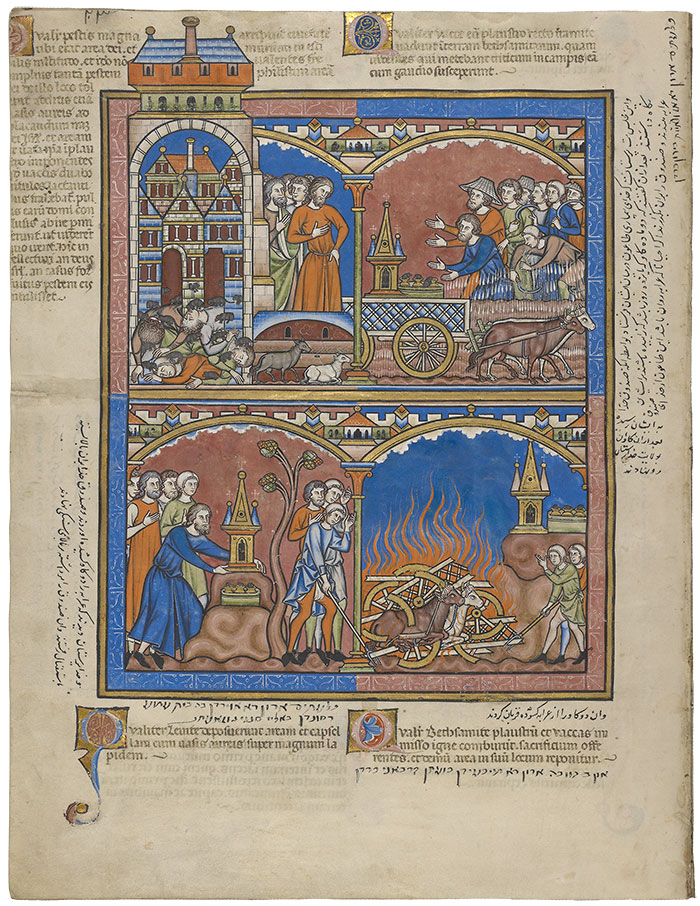MS M.638, fol. 21v

Plague in Ashdod, A Trespass Offering, The Ark in Beth Shemesh, A Burnt Offering
Old Testament Miniatures with Latin, Persian, and Judeo-Persian inscriptions
Purchased by J.P. Morgan (1867–1943) in 1916
Plague in Ashdod
A great pestilence settles upon Ashdod. Mice swarm in the fields and villages, feeding on the plague-ridden corpses. (1 Kings 5:6–7)
A Trespass Offering
The Philistines seek to rid themselves of the troublesome Ark. They prepare an offering to the Lord to atone for their thievery. After consulting priests and diviners, the Philistines ready a cart pulled by milk cows that have newly calved (the calves appear harnessed in the Philistine stable). Upon the cart, in addition to the Ark, they place rich, golden offerings representing each Philistine province. Thus laden, the cart is driven into the territory of Beth Shemesh, where joyous field workers receive it. The miniature painter has mistakenly included live mice among the offerings; the Bible states that these, too, were made of gold. (1 Kings 6:2–13)
The Ark in Beth Shemesh
The Levites remove the Ark from the cart, along with the golden offerings, and place them upon a great stone. (1 Kings 6:14–15)
A Burnt Offering
Having safely unloaded the Ark, the men of Beth Shemesh burn the cart and the milk cows as an offering to the Lord. The men tending the fire hold their hands before their faces to shield themselves from the intense heat. (1 Kings 6:14–15)
Folio 21v (Latin)
Upper left: How a great pestilence and an innumerable multitude of mice smote the city where the ark of God was, and for that reason, unable to sustain such a pestilence any longer, the Philistines removed the ark of God from that place, having added golden vessels to soothe the anger of the God of Israel. Then, putting the ark and the vessels themselves on a cart drawn by two suckgiving cows, their calves having been shut up at home, they let it go, that they might see where it went. For thus they were going to learn whether the God of Israel or a fortuitous chance had brought the pestilence upon them. (I Samuel 5:6 – 6:9)
Upper right: How the cows with the cart took the straight way to the land of the Beth-shemites. Seeing it, those who were reaping the wheat in the fields received it joyfully. (I Samuel 6:10–13)
Lower left: How the Levites took the ark and the coffer with the golden vessels and put it upon the great stone. (I Samuel 6:15)
Lower right: How the Beth-shemites set fire to the cart and the cattle and burnt them up, offering sacrifice, and at last the ark is restored to its place. (I Samuel 6:14)
Folio 21v (Persian)
Persian foliation: 23
Upper right margin: This is the image of the idolaters against whom God spread pestilence because they had captured the Ark of God. Afterwards, they [the Philistines] said to tie a cart to two [kine] who had given birth fifteen days before and place the Ark on it so that if the cart would roll, this pestilence of the Ark’s God would pass to them. Then, the kine turned toward the lands of the believers of God.
Lower left margin: The believers saw the cart pulled by two kine; they brought it; and the Ark of God was placed upon it. They went to welcome it and they removed the Ark and placed it upon a stone.
Lower right: They released the kine from the cart and sacrificed them.
Folio 21v (Judeo-Persian)
Upper right margin, corner: The Philistines carry the Ark our of the country.
Lower left, above Latin: The Philistines carry the Ark to Bethshemesh and place it on top of a rock.
Lower right, beneath Latin: Those two kine that had pulled the Ark were killed and offered in sacrifice.
Italicized words are in Hebrew.
Content consultant: Richard Leson
Persian translated by Sussan Babaie
Judeo-Persian translated by Vera Basch Moreen
Latin translation by Eran Lupu
After the commentary volume accompanying the Fine Art Facsimile edition by Faksimile Verlag Luzern